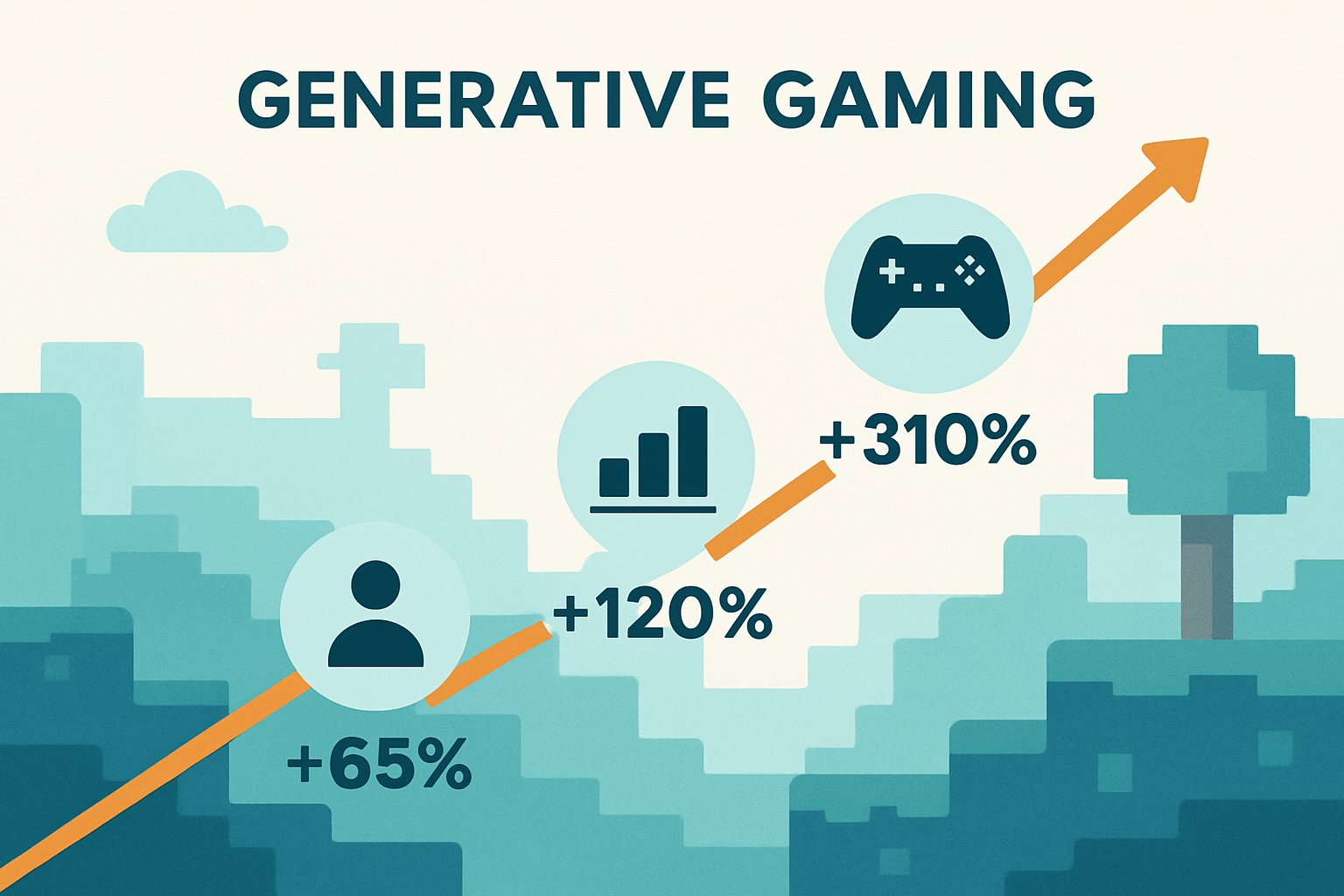
AI CERTS
9 hours ago
Generative Gaming: Real-Time Personalized Levels Transform Play
This article unpacks the technology, business signals, and design implications behind real-time personalized level generation. It also maps near-term actions for studios, tool vendors, and ambitious developers. Finally, we highlight the AI+ Designer™ certification that helps teams navigate this evolving frontier.
Market Momentum And Growth
Grand View Research values AI in gaming at roughly USD 3.28 billion for 2024. Furthermore, related reports forecast compound annual growth rates above 30 percent into the early 2030s. Generative Gaming features heavily in those models, spanning NPC logic, testing, and procedural level creation. In contrast, analyst methodologies differ, so treat absolute numbers as directional not deterministic.

Nevertheless, momentum feels tangible on production floors. Ubisoft runs Ghostwriter to generate NPC dialogue, while indie developers iterate entire worlds like Oasis. Moreover, middleware startups secure venture rounds by promising runtime creation pipelines for Unreal and Unity. Consequently, venture funding signals confidence that demand for adaptive, endless play spaces will rise.
Market data and funding converge on rapid expansion. However, numbers hide the technical machinery powering this surge, which the next section dissects.
Core Technology Stack Today
At the core sit world models, large neural networks learning game physics, visuals, and player agency loops. DeepMind’s Genie 3 headlines Generative Gaming technology, streaming 720p scenes with minute-scale memory for off-screen objects. Additionally, IPCGRL research demonstrates language-conditioned reinforcement agents that sculpt 2D levels on demand. These advances extend classical Procedural Content methods by adding learned probability distributions rather than hand-coded rules.
Meanwhile, Nvidia’s open-sourced Audio2Face and ACE cut latency for expressive characters that inhabit generated worlds. Inworld.ai complements that stack with an Unreal SDK bridging speech, LLM reasoning, and real-time animation. Consequently, a modular runtime now exists that any studio can assemble provided budget meets GPU requirements. For many teams, Generative Gaming pipelines knit these components into a single on-demand service.
World Models Rapid Rise
Genie 3 employs transformer backbones trained on gameplay video, action traces, and text prompts. Subsequently, the model predicts next frames and physics states, enabling interactive exploration rather than passive video. Researchers report 24 fps performance, yet compute remains cloud bound and expensive. Nevertheless, performance already outpaces many earlier PCGML prototypes.
World models thus convert research speculation into playable proof points. The following section shows how designers adapt workflows to exploit these engines.
Designer Workflow Shift Ahead
Design pipelines are evolving from linear authoring to tight human-AI co-creation loops. Moreover, promptable level prototypes arrive in seconds, letting designers test mechanics before asset teams commit. Generative Gaming empowers smaller teams to target content scopes once reserved for AAA budgets. However, creative oversight remains critical because generated geometry often requires repair passes.
Therefore, studios now hunt for hybrid talent comfortable with scripting, data curation, and artistic critique. Professionals can validate hybrid skills through the AI+ Designer™ certification. Additionally, agile teams bake telemetry into playtests, feeding analytics that drive player-specific Personalization rules.
Workflow evolution merges creativity with data science. Next, we weigh benefits against the stubborn limitations.
Benefits And Current Limits
Generative pipelines unlock several concrete gains.
- Scalability: Infinite levels sustain live service Engagement without inflating headcount.
- Personalization: Adaptive difficulty boosts retention metrics and session length.
- Rapid prototyping: Designers iterate mechanics earlier in development.
- Novel Entertainment experiences: Emergent sandboxes support unscripted player stories.
Consequently, player communities receive fresh Entertainment daily, reinforcing subscription loyalty. Nevertheless, drawbacks still slow mass rollout. Playability bugs, lore inconsistencies, and exploit loops appear when Procedural Content models hallucinate geometry. Moreover, real-time inference demands expensive GPUs or cloud credits. In contrast, classical handcrafted levels incur predictable costs but scale poorly. Generative Gaming also introduces fresh monetization channels through dynamic cosmetics and event prompts.
Legal And Ethical Hurdles
Legal debates intensify as models learn from copyrighted textures, architecture, and music. Subsequently, unions negotiate contract clauses protecting performer likeness within generative pipelines. Generative Gaming faces additional scrutiny when generated worlds mimic commercial franchises, as Oasis illustrated. Therefore, studios must audit datasets and implement moderation guardrails.
Benefits promise new revenue, yet challenges carry reputational and financial risk. The industry thus focuses on road maps that tackle cost, quality, and compliance simultaneously.
Future Road Map Ahead
Researchers aim to extend memory windows and physics fidelity while shrinking compute footprints. Meanwhile, hardware road maps signal dedicated generative inference chips entering consumer consoles within three years. Generative Gaming will then reach wider audiences, including mobile markets previously locked out by latency.
Additionally, hybrid verification pipelines combine rule-based validators with reinforcement learning agents that repair broken levels. Consequently, future toolchains may guarantee playability before content renders for the user. Personalization engines will also integrate biometric signals, allowing affect-driven difficulty curves.
Technical and hardware progress appears steady. However, pragmatic guidance remains necessary for present-day decision makers.
Actionable Industry Next Steps
Studios should initiate small pilots rather than bet entire franchises on unproven pipelines. Firstly, collect representative play traces and art references under clear licenses. Secondly, evaluate Procedural Content models offline using automated play testers before enabling live deployment. Thirdly, embed opt-out toggles and transparent messaging to respect player agency.
Moreover, finance teams must model per-player GPU costs against predicted lifetime value. Generative Gaming metrics should inform that calculus, measuring engagement impact against baseline titles. Finally, product leaders can upskill staff through the AI+ Designer™ program and related workshops.
These steps create structured experimentation instead of reckless hype. Consequently, organizations position themselves for sustainable advantage as the technology matures.
Real-time level generation is no longer science fiction. Generative Gaming now blends machine learning, designer intuition, and player data to craft unique journeys. Nevertheless, obstacles around cost, legality, and stability demand disciplined road maps rather than blind adoption. Therefore, forward-looking studios will run measured pilots, adopt verification safeguards, and train multidisciplinary talent. Additionally, professionals who earn the AI+ Designer™ credential gain vocabulary and methods to steer these initiatives. Act now to test, learn, and shape the next decade of personalized Entertainment. Download the certification guide and start building worlds that respond to every player.



